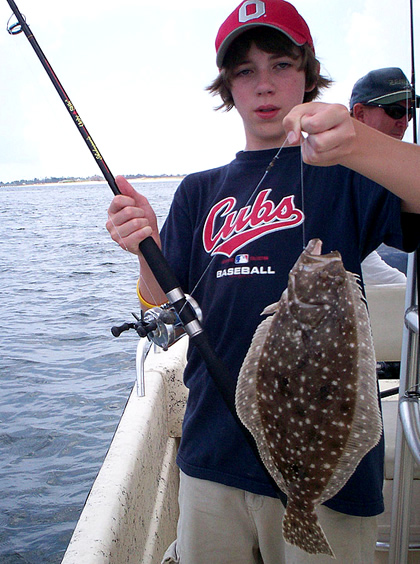The summer flounder, most commonly called fluke, is a member of the Bothidae family of flatfish, or left-eyed flounder. Fishing for summer flounder off jetties and bridges is a mainstay of mid-Atlantic coastal sportfishing.
Identification
The body is wide and somewhat flattened, rimmed by long dorsal and anal fins. Its mouth is large and well equipped with teeth. The eyes are on the left side of the body and close together. The teeth are well developed on the right side of the jaw. Background coloring is usually gray, brown, or olive but adjusts to the environment to keep the fish camouflaged. There are also many eyespots that change color. The blind side is white and relatively featureless.Size
The average summer flounder weighs 2 to 5 pounds, the latter being about 23 inches long. It is capable of growing to 35 inches in length but rarely does, and the all-tackle world record is a 22-pound, 7-ounce fish caught at Montauk, New York. Historical data indicate that female summer flounder may live up to 20 years, but males rarely exceed 7 years of age. |  |
Spawning behavior
Sexual maturity is reached at age 3. Spawning takes place during the fall and the winter, while the fish are moving offshore into deeper water or when they reach their winter location. Currents carry newly hatched flounder into the estuaries and sounds, where they undergo a transformation in shape and become bottom dwellers.Food and feeding habits
Adults are largely piscivorous and highly predatory, feeding actively in midwater, as well as on the bottom. Extremely fast swimmers, they often chase baitfish at the surface, which is not characteristic of most other flatfish. Fluke are known to eat what is available, including shrimp, crabs, menhaden, anchovies, silversides, sand launce, killifish, weakfish, hake, and other flounder.
Other Names
fluke, northern fluke, flounder; Dutch: zomervogel; French: cardeau d’été.Distribution
The summer flounder occurs in the western Atlantic from Maine to South Carolina and possibly to northeast Florida, and it is most abundant from Cape Cod to North Carolina.
Habitat
A bottom-dwelling fish, the summer flounder prefers sandy or muddy bottoms and is common in the summer months in bays, harbors, estuaries, canals, and creeks and along shorelines, as well as in the vicinity of piers and bridges or near patches of eelgrass or other vegetation. It typically prefers relatively shallow waters and depths of up to 100 feet during warmer months, then moves offshore in the winter to deeper, cooler water of 150 to 500 feet. |
| Fishing Summer Flounder |

